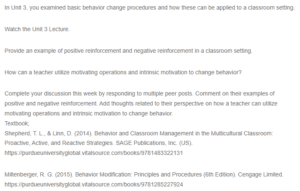Classroom Management Strategies
Classroom management is a vital tool, and teachers need to ensure they maintain control in class. As such, teachers can use both positive and negative reinforcement strategies in their classes to manage learners. Positive reinforcement occurs once a behavior is demonstrated to increase the chances of that act recurring (Shepherd & Linn, 2014). An example of positive reinforcement is when a learner raises their hand to answer questions in class, and the teacher calls on them. Subsequently, the learner is likely to lift their hands more in the future because they know this will make the teacher call on them to answer the question.
Therefore, in a class, positive reinforcement involves a teacher congratulating a learner for exhibiting the desired behavior. In contrast, negative reinforcement occurs in cases where a teacher criticizes a student for showing undesirable conduct. For instance, if a learner remains silent and sits throughout the lesson, the teacher might praise them with a verbal sticker or comment. On the contrary, if the learner speaks out of turn and is very disruptive, the tutor can give negative reinforcement like letters to their parents or a verbal warning.
Teachers can use setting explicit anticipations for desired actions and giving awards or other positive reinforcement to amend behavior through intrinsic motivation and motivational operations. Hence, if tutors need the students to participate more in class, they can set a target of learners least lifting their hands in every class session (Miltenberger, 2015). In turn, the learners who attain the objective will get positive reinforcement from the tutor in the form of little reward or verbal comments. On the other hand, the teacher can use intrinsic motivation to inspire the learner to engage in class activities by showing how participating in class would assist them in understanding the content better. When a tutor uses these strategies effectively, they can motivate learners to participate in class continually.
References
Miltenberger, R. G. (2015). Behavior Modification: Principles and Procedures (6th Edition). CengageLimited. https://purdueuniversityglobal.vitalsource.com/books/9781285227924.
Shepherd, T. L., & Linn, D. (2014). Behavior and Classroom Management in the Multicultural Classroom: Proactive, Active, and Reactive Strategies. SAGE Publications, Inc.(US). https://purdueuniversityglobal.vitalsource.com/books/9781483322131
ORDER A PLAGIARISM-FREE PAPER HERE
We’ll write everything from scratch
Question

Classroom Management Strategies
In Unit 3, you examined basic behavior change procedures and how these can be applied to a classroom setting.
Watch the Unit 3 Lecture.
Provide an example of positive reinforcement and negative reinforcement in a classroom setting.
How can a teacher utilize motivating operations and intrinsic motivation to change behavior?
Complete your discussion this week by responding to multiple peer posts. Comment on their examples of positive and negative reinforcement. Add thoughts related to their perspective on how a teacher can utilize motivating operations and intrinsic motivation to change behavior.
Textbook;
Shepherd, T. L., & Linn, D. (2014). Behavior and Classroom Management in the Multicultural Classroom: Proactive, Active, and Reactive Strategies. SAGE Publications, Inc. (US). https://purdueuniversityglobal.vitalsource.com/books/9781483322131
Miltenberger, R. G. (2015). Behavior Modification: Principles and Procedures (6th Edition). Cengage Limited. https://purdueuniversityglobal.vitalsource.com/books/9781285227924


